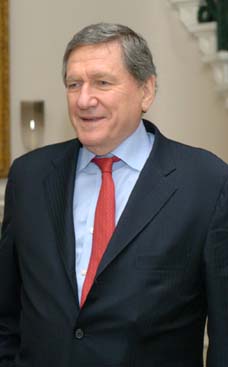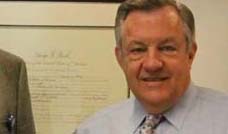
White began the lecture talking about the sun, which he said produces enough energy in one second to power the United States for 3.6 million years and has a surface temperature of 10,000 degrees Fahrenheit. After talking about the sun, White discussed novas, which he said literally translates from Latin to mean new. A red giant is a sun that has a radius of tens to thousands of times larger than our sun, and when it collapses it creates a white dwarf sun, which is a small sun much hotter than our sun, with a volume that can be similar to that of the Earth. White said white dwarf suns near red giant suns take gas from the red giant sun and explode. This process results in a nova. If the nova explosion is big enough, it can create a supernova. White explained the two types of supernovas are type 1A supernovas and the better known type 2 supernovas.
Lowell Observatory hosted a special lecture called “Star Go Boom! Supernovas and other really big explosions in space” by Kevin White, an educator at Lowell, who will soon be going to Ukraine for the Peace Corps
Lowell educator gives lecture on “really big explosions”
by Cathy Cooksey
on March 12, 2009
Caption: Volunteer Katherine Akers, a freshman astrophysics major, waits for more stargazers to come outside after the supernova lecture. - Mike Thompson/ The Lumberjack
Lowell Observatory hosted a special lecture called “Star Go Boom! Supernovas and other really big explosions in space” on March 4.
Kevin Schindler, the outreach manager for Lowell, started the program with a presentation of Lowell’s history.
Schindler said the lecture would be the last program given by Kevin White, an educator at Lowell, who will soon be going to Ukraine for the Peace Corps.
White began the lecture talking about the sun, which he said produces enough energy in one second to power the United States for 3.6 million years and has a surface temperature of 10,000 degrees Fahrenheit.
After talking about the sun, White discussed novas, which he said literally translates from Latin to mean new. A red giant is a sun that has a radius of tens to thousands of times larger than our sun, and when it collapses it creates a white dwarf sun, which is a small sun much hotter than our sun, with a volume that can be similar to that of the Earth.
White said white dwarf suns near red giant suns take gas from the red giant sun and explode. This process results in a nova. If the nova explosion is big enough, it can create a supernova. White explained the two types of supernovas are type 1A supernovas and the better known type 2 supernovas.
Type 1A supernovas occur when the white dwarf sun explodes not only itself, but also the red giant sun it was taking gas from. Type 2 supernovas are red super giants that have iron cores. When the iron cores collapse, the rest of the sun collapses and explodes, resulting in supernovas like the Crab Nebula.
White said that, according to the accounts of Chinese astronomers who saw the Crab Nebula explode approximately 1,000 years ago, it was so bright they could read at night.
White then discussed quasars, which he said were not explosions but more like running engines. Quasars are believed to be black holes that have a gravitational pull 1,000 times stronger than our sun. White said quasar 3C 273 is 2.5 billion light years away but produces as much light as 10 trillion suns.
“There aren’t any quasars around this area, only in the old, far parts of the universe,” White said. “If you consume the mass of two Earths every second, there’s only so much you can do before dying.”
White finished the lecture by talking about gamma ray bursts and how they remain mysterious to astronomers. White said gamma ray bursts have the same energetic explosion as 9,000 supernovas and a 10-second burst contains the equivalent of about 90 billion years’ worth of energy from our sun.
Sonya Kennedy, a Flagstaff resident, said the lecture was informative and she would like to come back to Lowell to listen to other lectures.
“I learned so much, all of it was so amazing,” Kennedy said. “I like how he compared the distances to something we know, like how many suns it would be like or how many light bulbs it would be. He makes me want to come back and learn some more.”
Schindler said Lowell’s Observatory usually has lectures on Wednesday nights, which they call “Flagstaff night.”
“What we do is we give people who live in Flagstaff half off,” Schindler said. “If anyone wants to know what the lectures are about, they can look in the newspaper or go to our Web site, www.lowell.edu.”











